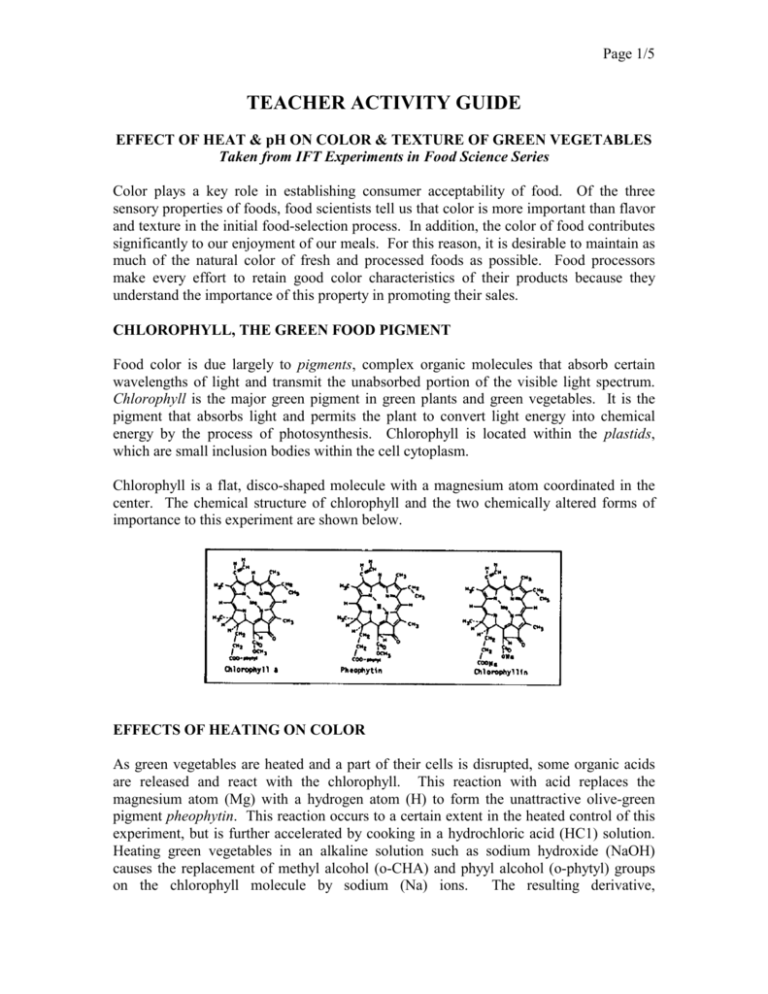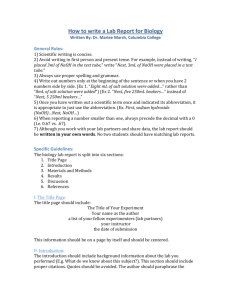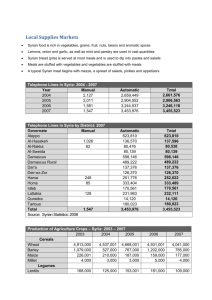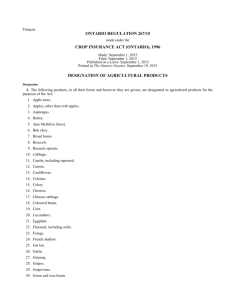Effect of Heat & pH on Color & Texture of Green Vegs
advertisement

Page 1/5 TEACHER ACTIVITY GUIDE EFFECT OF HEAT & pH ON COLOR & TEXTURE OF GREEN VEGETABLES Taken from IFT Experiments in Food Science Series Color plays a key role in establishing consumer acceptability of food. Of the three sensory properties of foods, food scientists tell us that color is more important than flavor and texture in the initial food-selection process. In addition, the color of food contributes significantly to our enjoyment of our meals. For this reason, it is desirable to maintain as much of the natural color of fresh and processed foods as possible. Food processors make every effort to retain good color characteristics of their products because they understand the importance of this property in promoting their sales. CHLOROPHYLL, THE GREEN FOOD PIGMENT Food color is due largely to pigments, complex organic molecules that absorb certain wavelengths of light and transmit the unabsorbed portion of the visible light spectrum. Chlorophyll is the major green pigment in green plants and green vegetables. It is the pigment that absorbs light and permits the plant to convert light energy into chemical energy by the process of photosynthesis. Chlorophyll is located within the plastids, which are small inclusion bodies within the cell cytoplasm. Chlorophyll is a flat, disco-shaped molecule with a magnesium atom coordinated in the center. The chemical structure of chlorophyll and the two chemically altered forms of importance to this experiment are shown below. EFFECTS OF HEATING ON COLOR As green vegetables are heated and a part of their cells is disrupted, some organic acids are released and react with the chlorophyll. This reaction with acid replaces the magnesium atom (Mg) with a hydrogen atom (H) to form the unattractive olive-green pigment pheophytin. This reaction occurs to a certain extent in the heated control of this experiment, but is further accelerated by cooking in a hydrochloric acid (HC1) solution. Heating green vegetables in an alkaline solution such as sodium hydroxide (NaOH) causes the replacement of methyl alcohol (o-CHA) and phyyl alcohol (o-phytyl) groups on the chlorophyll molecule by sodium (Na) ions. The resulting derivative, Page 2/5 chlorophyllin, is a bright-green pigment. Removal of the phytyl alcohol group from the chlorophyll molecule makes the chlorophyllin water soluble. Thus, in this experiment, cooking in the NaOH solution converts a portion of the chlorophyll molecules to chlorophyllin, which is then leached from the vegetable into the drained solution. EFFECT OF HEATING ON TEXTURE The cell is the basic structural unit of all plant tissues. These cells are surrounded by cell walls that provide an elastic support for retaining the contents of the cell. The cell also has a cell membrane layer, which is located just inside the cell wall and which controls the passage of liquids into and out of the cell. The cell is filled with a jelly-like substance, termed the cytoplasm, which is composed of protein, sugars, salts, and other substances dispersed in water. Mature cells also contain vacuoles, which are separate compartments filled with a fluid, cell sap, and are composed of dissolved sugars, salts, organic acids, pigments, and other materials. Also located within the cytoplasm are separate inclusion bodies, called plastids, which contain the chlorophyll. These plastids are only about 4-10 nanometers (nm) in diameter. Most vegetables, including the green vegetables, contain significant amounts of hemicellulose, which provides strength to their cell wall structures. Hemicellulose is partially solubilized during heating, especially in the presence of alkaline solutions. Thus, the vegetable that is heated in the NaOH solution will exhibit the poorest texture of all the heated products. MATERIALS REQUIRED Fresh or frozen green beans, cut into 1-inch lengths Dilute HC1 solution (0.01N HC1) Dilute NaOH solution (0.01N NaOH) Distilled water or tap water Bunsen burner Timer or wall clock 250-mL beakers with watch glasses 100-mL graduated cylinders Weighing balance Twelve 15-cm-diameter filter paper discs Stirring rods or magnetic stirrer Heat-resistant gloves or tongs Spatula or table fork Litmus paper strips or pH-indicating paper Marking pen TEACHING TIPS 1. Frozen, cut green beans may be obtained from the local supermarket. Page 3/5 2. A 0.01N solution of HC1 is prepared by adding 0.86 mL of pure HC1 to 1,000 mL of distilled water (H2O). 3. A 0.01 N solution of NaOH is prepared by adding 0.4 g of pure NaOH to 1,000 mL of distilled H2O. 4. Although specific glassware and other equipment and supplies are listed in the experiment, you may substitute other appropriate items that may be more readily available. A magnetic stirrer will be helpful, if one is available. 5. This experiment may be conducted as a class demonstration by the instructor or as individual work by the students. Solutions and vegetables may be prepared ahead of time by the instructor, or, if they have adequate experience and time, by the students themselves. 6. Solutions and heating experiments in this project are not particularly hazardous. The solutions are only mildly acidic or alkaline. However, as a matter of good laboratory procedure, students should be instructed to exercise care in handling all chemical solutions and to avoid contact with skin, eyes, and clothing. Heating and boiling of solutions should be done with care to avoid burns to the hands and body. Beakers should be kept covered while heating and insulated gloves or tongs should be used for handling hot containers. Adequate eye protection is recommended for this experiment, again as a precaution and as a good and safe laboratory procedure. STUDENT EXPERIMENTAL PROCEDURE 1. Label four beakers, cylinders, and filter paper discs as follows: 0.01N HC1 0.01N NaOH Heated control (distilled or tap water) Unheated control (distilled or tap water) 2. Weigh about 20 g of green beans into each of the four beakers. 3. Add 100 mL of the above solutions or water to the labeled beakers. 4. Cover the beakers with a watch glass. Stir occasionally with a glass rod or continuously with a magnetic stirrer at a slow speed. 5. Heat each of the beakers except the unheated control to maintain a slow boil (simmer) for exactly 15 minutes. Do not heat the unheated control. 6. Observe and record changes in the appearance of the beans and the solutions in each beaker during the heating treatment. Page 4/5 7. Allow the beakers to cool and then drain the solutions into their correspondingly labeled graduated cylinders. Drain the unheated control beaker into its graduated cylinder. 8. Pour the drained beans onto the correspondingly labeled filter paper discs. 9. Determine and record the pH of each cooking solution and the water in the unheated control in the table provided. 10. Observe and record the color characteristic and the color intensity for each drained solution. 11. Observe the changes in texture (firmness) of each of the green beans by crushing or cutting them with your spatula or table fork. Record these data also. QUESTIONS AND ANSWERS 1. What is the temperature of water used for heating the beans in your experiment? How does this temperature compare with that used for commercial processing of vegetables. Ans. The temperature of boiling solutions is about 100˚C (212˚F), which is considerably lower than the 116-121˚C (240-250˚F) used by commercial food processors for canning foods. 2. Which of your solutions were near neutral? Acidic? Alkaline? Ans. The distilled or tap water solutions will be near neutral, the HC1 solution acidic, and the NaOH solution alkaline. 3. Which pH solution provided the best color and texture retention in the heated beans? Ans. The NaOH solution will provide best color retention but produce the poorest texture, soft and mushy. 4. Which pH solution provided the poorest color retention in the heated beans? Ans. The HC1 solution will provide the poorest color retention. 5. What pigment is responsible for the observed changes in color of the cooked vegetables? Ans. Chlorophyll is the pigment responsible for the green color of vegetables. Page 5/5 6. What reaction is responsible for loss of texture (firmness) in cooked green beans? Ans. Heat destruction (solubilization) of hemicellulose is responsible for most of the loss of firmness. DATA TABLE (Typical Results) Color and Texture Color Drained solution Treatment Unheated control Heated control Acetic acid pH 6-7 6-7 Drained beans Bean Intensity Intensity texture Characteristic (0-10 Characteristic (0-10 (0-10 color scale) color scale) Scale Clear, no 0 Bright green 10 10 color Pale green 1 Yellow5 5 Yellow-green Acid Pale green (litmus paper is red) Sodium Alkaline Yellow Yellow--brown bicarbonate (litmus paper is blue) 1 Olive green 2 8-9 5-6 Dull green 7 1








